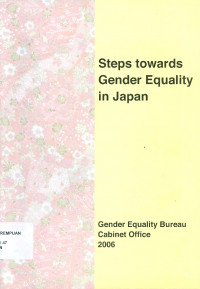
Text
Steps towards gender equality in Japan-Gender Equality Bureau Cabinet Office 2006
The labor force ratio of female Japanese employees is characterized by an Mshaped curve. As shown in Fig. 1, the number of female workers has tended to decline when women are in their late 20s through 30s and then increase again they are in their late 30s through 40s. This can be explained by the fact that, in the 20th century, many female employees retired when they got married to begin raising children. After child care duties were completed (e.g., when children reached school age), many returned to work, only to find that the only jobs available to them were poorly paid part-time positions. As gender-related labor laws have been implemented and revised, female employees now tend to keep their jobs throughout marriage and the child-rearing years. These improved labor laws have contributed to the restructuring of the Mshaped curve. The following sections review the development of some of Japanʼs labor laws that specifically address gender inequality. However, women's participation in Japan's policy decision-making processes remains low, and the percentage of women in the labor force drops during the primary marriage and childbearing/rearing period of the early 30s. Opportunities for women to exert their abilities and fully contribute to society are insufficient. At the same time, to respond to the rapid changes occurring in Japan's socioeconomic situation, such as the trend toward fewer children, the aging of the population, and the maturation of domestic economic activities, it has become a matter of urgent importance to achieve a gender-equal society in which men and women respect the other's human rights and share responsibilities, and in which every citizen is able to fully exercise their individuality and abilities regardless of gender. In light of this situation, it is vital to position the realization of a gender-equal society as a top-priority task in determining one of Japan's 21-century frameworks, and to implement policies related to promotion of formation of a Gender-equal Society in all fields.
Availability
| KP.II-00134 | KP,II GOV S | My Library | Available |
Detail Information
- Series Title
-
-
- Call Number
-
KP.II INT s
- Publisher
- Nagata : Gender Equality Bureau Government of Japan., 2006
- Collation
-
30 hal.: ill. ; 30cm.
- Language
-
English
- ISBN/ISSN
-
-
- Classification
-
KP.II
- Content Type
-
-
- Media Type
-
-
- Carrier Type
-
-
- Edition
-
-
- Subject(s)
- Specific Detail Info
-
-
- Statement of Responsibility
-
-
Other version/related
No other version available
File Attachment
Comments
You must be logged in to post a comment
 Computer Science, Information & General Works
Computer Science, Information & General Works  Philosophy & Psychology
Philosophy & Psychology  Religion
Religion  Social Sciences
Social Sciences  Language
Language  Pure Science
Pure Science  Applied Sciences
Applied Sciences  Art & Recreation
Art & Recreation  Literature
Literature  History & Geography
History & Geography